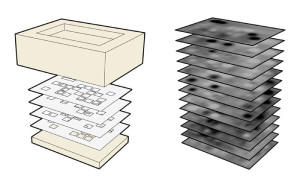A friend recently sent me a link to an article that was written more than a year ago. In it, writer Cameron Naramore explores the possibility that 3D printers could someday spy on their users. He references the practice of Steganography, describing how large 2D printer manufacturers like Epson and Xerox embed tiny markings during a print job as a way of tracking the use of their printers:
The process of hiding a message inside a message is called steganography and originally these codes were implemented to convince the government that the printers couldn’t be used to forge money; any bills with mysterious dots that showed up under certain lights would be known to be counterfeit. Now however, the codes store information like the model and serial number of the printer and timestamps. That’s pretty useful forensic data. Apparently printing on paper is not entirely anonymous.
Cameron extrapolates that this method could also be used in 3D printing, referencing Stratasys’ confiscation of Cody Wilson’s leased unit when he attempted to print a gun as a sign that it’s not out of the question for a manufacturer to collude with the government. He asks, “What if your MakerBot sent an alert to HQ if you tried to print a gun, or what if it returned a copyright infringement error if you tried to print a Nike swoosh? I’m sure IP attorneys would lobby for it.“
Cameron’s paranoia was a premonition of what would happen almost six months after he wrote that post. With the revelations of Edward Snowden — a phrase that will go down in history — it’s become clear that spying on ordinary civilians is exactly the sort of thing that governments and corporations would do. As 3D printers become more widespread and capable enough to produce contraband, it’s entirely likely that the powers-that-be would find ways of controlling 3D prints through software, files and machines.

While I haven’t come across any stories of companies suing individuals about 3D printed IP infringement — just 3DP manufacturers suing other manufacturers — it’s definitely on the minds of a lot of people. At every conference I’ve attended, speakers, like IP lawyer John Hornick, address crowds of people about the future implications of 3D printing on existing copyrights. Research firm Gartner made the prediction that, by 2016, there would be $15 billion worth of IP theft reported due to 3D printing. The Pirate Bay announced that the illegal file sharing site would include 3D models for download and already hosts the files for the Liberator 3D printed gun. The fear of IP theft seems to be palpable, as is the threat.

Create it REAL, meanwhile, believes that they can hinder gun printing with software that will recognize specific “gun-like” parts and halt a print job. When this method is combined with those mentioned above, it’s possible that such embedded watermarks might send a signal to a printing program to prevent the manufacturing of specific prints. When the time comes for Disney to release its 3D files onto the web, they may consider encoding such data into their models for such a purpose. What remains to be seen is if such techniques will be implemented to prevent unwanted uses of 3D printing.
In some ways, I’m used to companies and governments controlling the flow of some data. Disney has the right to guard its intellectual property (though, personally, I think it should probably belong to Disney’s employees, instead). And you can find my opinions on gun control in other places on 3DPI. For those reasons, I’m not particularly concerned about embedded watermarks. Users of the Pirate Bay will likely find ways around those anyway. What concerns me more is the more startling tactics that could be employed to track contraband 3D printer useage.
The United States government has already been caught installing monitoring devices into laptops and monitoring smart phones. Of course, corporations have been complicit in such illegal and unconstitutional activities. Microsoft, for instance, has been documented as monitoring and recording Skype conversations, which are then handed over to law enforcement agencies. Additionally, representatives of the company have previously voiced the desire to include data collection in the first generation of the Microsoft Kinect for marketing analysis. If Stratasys colludes with the US government to allow them to track the print-tracking webcam installed in the new MakerBots, that’s when control over 3D printing will start to scare me.
I’d rather not live in a world of secret communications, underground networks in which vital 3D printed med files are transferred through encryption software, such as that developed by artist Matthew Plummer-Fernandez, because they violate a corrupt drug company’s patent. The good news is that we’re still in the early stages of the 3D printing game here. The Electronics Frontier Foundation is one organization working to combat control over 3D printing, specifically through patents on the technology. To enhance these efforts: we can begin placing pressure on our governments and corporations, before 3D printing gets too mainstream, to prevent such tactics, as seen with our other technologies, from taking place. We don’t have to stop it there, either. All citizens can write or call their representatives to ensure that environmentally harmful products for and uses of 3D printing don’t take place. Shareholders with stock in 3D printing companies can ask, as investors, that their corporations do the same. If 3D printing really represents a democratizing technology, then we should start making sure it’s democratic before it’s too late.


